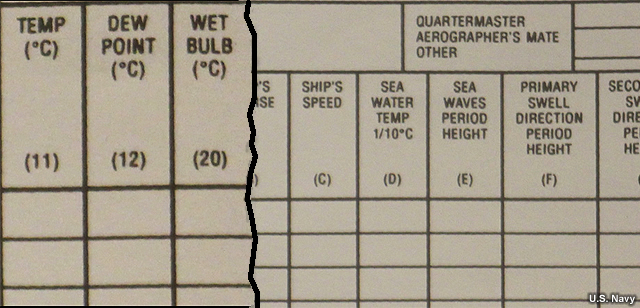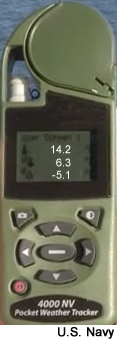Your Observation and Report
You find an appropriate place on the deck, out of the sun and away from obstructions, and take your temperature measurements. Based on your measurements, let's encode the temperature observations.

On your reporting form, the air temperature is reported as the dry-bulb temperature to the nearest tenth degree Celsius (17.6 degrees C). Prefix subzero values with an "M" (M08.2). If the temperature is missing, leave this entry blank and do not encode dewpoint or wet bulb temperatures.
The dewpoint temperature is entered to the nearest whole degree Celsius. Prefix subzero dewpoints with an "M". Enter statistical data, such as the water equivalent of the dry bulb temperature below -37 degrees C, in parentheses.
The wet bulb temperature is also entered to the nearest tenth degree Celsius. Prefix subzero wet bulbs temperatures with an "M".
Sea water temperature should be reported to the nearest tenth degrees Celsius (e.g., 15.4 degrees C). Enter "M" for missing data.
Based on the readings in the image above of temperature, dewpoint, wet bulb and sea water temperature, how would you encode them on the form? Type your answers in the boxes, then click Done.

The sea water temp is: 10.2 °C
Temperature: 14.2, Dewpoint: M05, Wet bulb temperature: 6.3, Sea water temperature: 10.2. Record air temperature, wet bulb temperature, and sea water temperature to the nearest 0.1 C. The dewpoint temperature is encoded to the nearest 1 degree. Negative numbers are preceded by "M," which is why the encoded dewpoint begins with the letter.